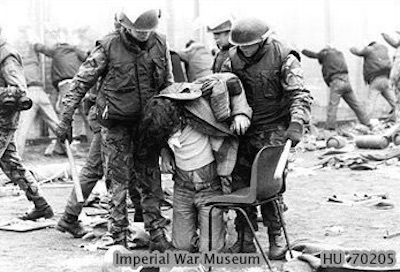
The British government secretly authorised the use of a chemical riot control agent, fired from aerosols, water cannon or dropped from the air, to be used on republican PoWs at the height of the conflict, it has been confirmed.
Papers from 1976 obtained by the Observer newspaper under the British government’s freedom of information legislation show that the use of ‘CR’ or Dibenzoxazepine -- a skin irritant 10 times more powerful than other tear gases -- was permitted from 1973 to be used on the prisoners in the event of an attempted mass breakout.
The documents confirm that British ministers ordered the chemical agent to be moved to prisons in Ireland from July 1974. They show that the authorisation was so sensitive that officials involved in organising training with the chemical were warned of the consequences of “idle talk”.
The man behind this highly classified order was David B. Omand, a senior official in the Ministry of Defence. He later rose to become head of security and intelligence at the Cabinet Office, one of the most senior in the British government.
News of the disclosures will further inflame the controversy over the use of the chemical in October, 1974, to quell rioting at Long Kesh prison, something British ministers have always refused to discuss. The prison held some of the most prominent republicans at the time, including Gerry Adams. More than 50 of the prisoners at Long Kesh who were sprayed with the chemical have died or have developed cancerous illnesses.
Jim McCann, who was in Long Kesh between 1973 and 1981, has led a campaign for full disclosure of the use of what amounted to a chemical weapon.
‘I’ll never forget it, there were grown men screaming for their mothers,’ he said. ‘We’d all had experience in CS gas, which was easy to avoid, but this was something different, you couldn’t get away from it. I felt like I was on fire. They just decided to experiment on us like we were guinea pigs.’
Sinn Fein spokesman Richard McAuley, who was also at Long Kesh at the time of the riot, said the chemical had been dropped in capsules from a helicopter and sprayed by soldiers inside the prison.
‘It was like a thick fog,’ he said. ‘People were being sick and their eyes were streaming. It was a very frightening experience. The truth of what happened should be told.’
The use of CR became a priority in 1976 when the government became concerned about a backlash in prison following the removal of Special Category status for IRA prisoners. This effectively meant they were no longer treated as political prisoners.
The documents also show that British Prime Minister James Callaghan authorised the use of the chemical agent to be fired from water cannon, in a device called ‘Pigsquirt’. He also authorised the use of a device called ‘Pussycat’ which fired a polyethylene capsule that threw liquid CR on rioters on impact with the security fence of a prison.
The effects of CR are similar to the more common riot control agent CS gas, except that it also induces intense pain to exposed skin. The affected areas remain sensitive for days and become painful again after contact with water.
The use of chemical weapons and riot gases were limited by international agreement at the time. Further notes from senior officials show that training was carried out in absolute secrecy in a secure training area, in case it raised suspicions -- there was ‘no way the public could find out about the intention to use chemicals’.
HOODED MEN GET COURT DATE
In a separate development, a group of interned prisoners who were tortured in 1971 have cleared the first stage in a legal battle to have their case fully investigated.
Lawyers representing the “hooded men” were granted leave to seek a judicial review at the High Court in Belfast.
Last year the 26 County government asked the ECHR to revise its 1978 judgment that they had been victims of inhuman and degrading treatment, but short of a finding of torture.
The controversial judgement is said to have encouraged British ministers to continue to develop and implement torture techniques in conflicts around the globe.
The men are also seeking a full inquiry into their treatment.
Granting leave to seek a judicial review in both applications, Mr Justice Treacy ruled they should proceed “in tandem”. There will be a full hearing over four days starting on November 30.
![[Irish Republican News]](https://republican-news.org/graphics/title_gifs/rn.gif)
![[Irish Republican News]](https://republican-news.org/graphics/title_gifs/harp.gif)

